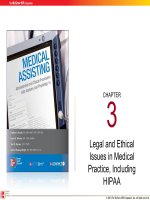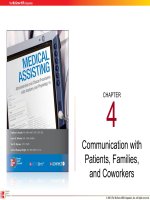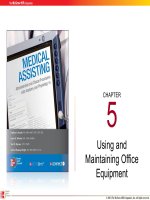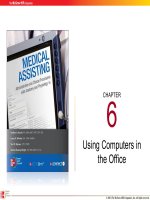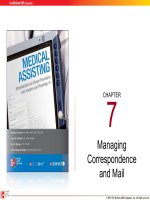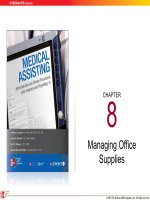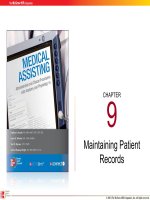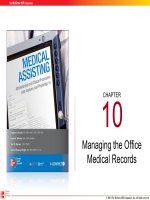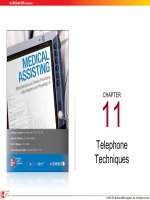Lecture Medical assisting: Administrative and clinical procedures with anatomy and physiology (4e) – Chapter 9
Bạn đang xem bản rút gọn của tài liệu. Xem và tải ngay bản đầy đủ của tài liệu tại đây (842.84 KB, 55 trang )
CHAPTER
9
Maintaining Patient
Records
© 2011 T he McGraw -Hill Com panie s, Inc. A ll rights reserv ed.
9-2
Learning Outcomes
9.1 Explain the purpose of compiling patient
medical records.
9.2 Describe the contents of patient record
forms.
9.3 Describe how to create and maintain a
patient record.
9.4 Identify and describe common approaches to
documenting information in medical records.
© 2011 T he McGraw -Hill Com panie s, Inc. A ll rights reserv ed.
9-3
Learning Outcomes (cont.)
9.5 Discuss the need for neatness, timeliness,
accuracy, and professional tone in patient
records.
9.6 Discuss tips for performing accurate
transcription.
9.7 Explain how to correct a medical record.
© 2011 T he McGraw -Hill Com panie s, Inc. A ll rights reserv ed.
9-4
Learning Outcomes (cont.)
9.8 Explain how to update a medical record.
9.9 Identify when and how a medical record may
be released.
9.10 Discuss the advantages and disadvantages
of the electronic medical record, also known
as the electronic health record.
© 2011 T he McGraw -Hill Com panie s, Inc. A ll rights reserv ed.
9-5
Introduction
• Medical records document the evaluation and
treatment of patients
– Critical to patient care
– Sectioned to describe various aspects of patient
information and care
– Legal documents
• Medical assistant has a major role in
documenting in and maintaining patient records
© 2011 T he McGraw -Hill Com panie s, Inc. A ll rights reserv ed.
9-6
Importance of Patient Records
• The patient’s chart
–
Past and present medical conditions
–
Communication tool for health-care team
• Plan to provide for continuity of care
–
Documentation for billing and coding
–
Patient education and research
–
Legal document admissible in court
© 2011 T he McGraw -Hill Com panie s, Inc. A ll rights reserv ed.
9-7
Importance of Patient Records (cont.)
• Information included in patient record
–
Name and address
– Current complaint
–
Insurance coverage and
person responsible
for payment
– Health-care needs
–
Occupation
– Medical treatment plan
–
Medical history
– Response to care
– Lab and radiology
reports
© 2011 T he McGraw -Hill Com panie s, Inc. A ll rights reserv ed.
9-8
Legal Guidelines for Patient Records
© 2011 T he McGraw -Hill Com panie s, Inc. A ll rights reserv ed.
9-9
Standards for Records
• Complete, accurate, and well-documented
records are evidence of appropriate care
• Incomplete, inaccurate, altered, or illegible
records may imply a poor standard of care
• Everyone who documents in the patient record
has a responsibility to the patient and employing
physician
© 2011 T he McGraw -Hill Com panie s, Inc. A ll rights reserv ed.
9-10
Patient Records
Patient
Education
• Test results
• Health issues
• Treatment
instructions
Additional Uses of
Patient Records
Research
• Source of data
Quality of
Treatment
• Peer review
• TJC review
• Health-care
analysis and
policy decisions
© 2011 T he McGraw -Hill Com panie s, Inc. A ll rights reserv ed.
9-11
Apply Your Knowledge
What is the purpose of documentation in a patient’s
medical record?
ANSWER: Documentation in the medical record
provides evidence of appropriate care. If a
procedure is not documented, it is considered not
done.
© 2011 T he McGraw -Hill Com panie s, Inc. A ll rights reserv ed.
9-12
Standard Chart Information
Patient Registration Form
Date
Patient demographic information
Age, DOB
Address
SSN
Insurance/financial information
Emergency contact
© 2011 T he McGraw -Hill Com panie s, Inc. A ll rights reserv ed.
9-13
Standard Chart Information (cont.)
• Patient medical history
–
Illnesses, surgeries, allergies, and current medications
–
Family medical history
–
Social history (diet, exercise, smoking, use of drugs and alcohol)
–
Occupational history
–
Current patient complaint recorded in patient’s own words
© 2011 T he McGraw -Hill Com panie s, Inc. A ll rights reserv ed.
9-14
Standard Chart Information (cont.)
• Physical examination results
• Results of laboratory and other
tests
• Records from other physicians
or hospitals
– Include a copy of the patient
consent authorizing release of
information
© 2011 T he McGraw -Hill Com panie s, Inc. A ll rights reserv ed.
9-15
Standard Chart Information (cont.)
• Doctor’s diagnosis and treatment plan
–
–
–
–
Treatment options and final treatment list
Instructions to patient
Medication prescribed
Comments or impressions
• Operative reports, follow-up visits, and
telephone calls
– These are part of the continuous patient record
– Document calls made to and from the patient
© 2011 T he McGraw -Hill Com panie s, Inc. A ll rights reserv ed.
9-16
Standard Chart Information (cont.)
• Informed consent forms
–
Verify that the patient understands procedures, outcomes, and options
–
Patient may withdraw consent at any time
• Hospital discharge summary forms
–
Information summarizing the patient’s hospitalization
–
Instructions for follow-up care
–
Physician signature
© 2011 T he McGraw -Hill Com panie s, Inc. A ll rights reserv ed.
9-17
Standard Chart Information (cont.)
• Correspondence with or about the patient
–
All written correspondence regarding the patient
–
Record date item was received on the actual form
• Information received by fax – request an original
copy
• Date and initial everything you place in the chart
© 2011 T he McGraw -Hill Com panie s, Inc. A ll rights reserv ed.
9-18
Apply Your Knowledge
What section of the patient record contains
information about smoking, alcohol use, and
occupation?
ANSWER: Information about smoking, alcohol use,
and occupation is part of the patient’s past medical
history.
© 2011 T he McGraw -Hill Com panie s, Inc. A ll rights reserv ed.
9-19
Initiating and Maintaining Patient Records
Completing medical
history forms
Documenting
test results
Initial
Interview
Examination,
preparation,
and vital signs
Documenting
patient
statements
© 2011 T he McGraw -Hill Com panie s, Inc. A ll rights reserv ed.
9-20
Initiating and Maintaining Patient Records
(cont.)
• Follow-up
–
Transcribe notes the doctor dictates
–
Post results of laboratory tests and examinations
–
Record all telephone communication with the client
–
Record all medical or discharge instructions given to the client
© 2011 T he McGraw -Hill Com panie s, Inc. A ll rights reserv ed.
9-21
Apply Your Knowledge
In addition to transcribing notes the doctor dictates
and posting lab results, what are two other followup tasks the medical assistant might be required to
perform as part of follow-up to a patient
appointment?
ANSWER: The medical assistant
may have to record telephone
calls with the patient, as well as
medical or discharge instructions
given to the patient.
Right!
© 2011 T he McGraw -Hill Com panie s, Inc. A ll rights reserv ed.
9-22
The Six Cs of Charting
Client’s words – Do not interpret patient’s words
Clarity –
Precise descriptions/medical terminology
Completeness – Fill
C out forms completely
onciseness – To the point/approved abbreviations
Chronological order – Legal issues
confidentiality –
Follow HIPAA guidelines
© 2011 T he McGraw -Hill Com panie s, Inc. A ll rights reserv ed.
9-23
Apply Your Knowledge
What are the six Cs of charting?
ANSWER: The six C’s of charting are
Client’s words
Conciseness
Clarity
Chronological order
Completeness
Confidentiality
© 2011 T he McGraw -Hill Com panie s, Inc. A ll rights reserv ed.
9-24
Types of Medical Records
Source-Oriented Medical
Records
Problem-Oriented
Medical Records
• Conventional approach
• POMR records make it
easier to track specific
• Information is arranged
illnesses
according to who supplied
the data
• Information included
– Database
• Problems and treatments are
on the same form
– Problem list
• Difficult to track progress of
– Educational, diagnostic,
and
specific events
treatment plans
– Progress notes
© 2011 T he McGraw -Hill Com panie s, Inc. A ll rights reserv ed.
9-25
Types of Medical Records (cont.)
• SOAP documentation
–
Orderly series of steps for dealing with any medical case
–
Lists the following
• Patient symptoms
• Diagnosis
• Suggested treatment
© 2011 T he McGraw -Hill Com panie s, Inc. A ll rights reserv ed.

